Abstract
To improve the quality and control accuracy of the farming tractor electro-hydraulic hitch system, a variable-universe fuzzy control algorithm is introduced herein based on force–position mixed adjustment. (1) Background: This research sought to improve the operation quality and control precision of the tractor electro-hydraulic suspension operation system by solving the slow response and low precision problems in the target value control of the system. (2) Methods: According to the characteristics of the operating system, the working principle is discussed. The variable-universe fuzzy controller and the control module were designed based on MC9S12XS128. At the same time, we used Matlab/Simulink to study the step response, and field tests were carried out based on the existing test conditions. (3) Results: In the response stage, the variable-universe fuzzy control only needs 5.85 s, and there is no overshoot problem; in the normal tillage stage, the maximum tillage depth difference is only 1.6 cm, and the traction force is 428 N, which is closer to the expected value. (4) Conclusions: The farming quality and efficiency of the operating system were improved. Additionally, the operating system can also provide technical support for intelligent agricultural machinery and the field management mode in the future.
1. Introduction
The electronically controlled hydraulic suspension system is a key module for modern agricultural tractors to lift agricultural implements, providing power for various coupled agricultural machinery [1]. As a technology-intensive, closed-loop adjustment control unit, electro-hydraulic control technology plays an extremely important role in national industrial manufacturing and modern agricultural production [2]. Especially in the adjustment of tillage depth, the electronically controlled hydraulic suspension system continues to improve the efficiency and quality of tractor operation by virtue of its unique control advantages, and it has also become a hot topic in current agricultural machinery research [3,4,5].
At present, research on tillage depth adjustment and system control has been quite mature and has been widely used in various tractor products [6,7]. Regarding the adjustment of tillage depth, scholars have proposed the theory of dual parameter adjustment [8,9], but the current actual production is still dominated by single parameter adjustments such as resistance or position; in the control algorithm, although the introduction of fuzzy control, variable-universe theory and other ideas [10,11] effectively alleviate the strong nonlinear problems caused by time-varying system and disturbance and improve the quality of farming, its reliability and durability need to be optimized.
Patrick Opdenbosch et al. [12] designed a control algorithm to learn the inverse input-state map of an electro-hydraulic poppet valve (EHPV) with the aid of a nodal link perceptron network (NLPN). While in operation, the controller enforces the tracking of a desired hydraulic supply pressure profile while it learns the inverse input-state calibration map and monitors the latter for deviations from prescribed bounds. The tracking performance of the auto-calibration scheme is validated experimentally, and the fault detection algorithm is explored via a computer simulation. Reza Mohammadikia and Mortaza Aliasghary [13] proposed an interval type-2 fractional order fuzzy PID (IT2FOFPID) strategy designed in the tractor AS system to minimize the transmitted uneven surface fluctuations to the driver’s cabin. Therefore, a biogeography-based optimization (BBO) algorithm was employed to regulate the parameters of controllers. To demonstrate the advantages of the IT2FOFPID controller, three different controllers involving type-1 fuzzy PID (T1FPID), fractional order fuzzy PID (FOFPID), and interval type-2 fuzzy PID (IT2FPID) control methods were considered. The validity of the proposed IT2FOFPID controller is demonstrated in comparative simulation results in the presence of various field disturbances. The findings revealed that the proposed controller makes outstanding yield compared to other controllers in the presence of road disturbances. Shuhan Wang et al. [14] proposed a double-input-and-double-output fuzzy logic controller (DIDO-FLC) that is designed and introduced in the control strategy, which can adjust the fast-filling time and the maximum fast-filling pressure of the clutch simultaneously. In order to validate the proposed strategy, the results of the vehicle test are presented, which demonstrate that the deviations are effectively diminished and the shifting quality is obviously improved. Sabouri, Y., Abbaspour-Gilandeh, Y. et al. [15] researched a depth-control system for the subsoiler of the tillage at various depths. In their study, a depth control system, an algorithm, and a program were designed to control the subsoiler depth. In their study, four compression sensors were used at a distance of 10 cm up to a depth of 40 cm on the blade mounted at the tractor’s front. The data of these sensors were used as the input and compared with the pressure baseline limit (2.07 MPa), and with the priority to select the greater depth, the depth of the subsoiler was determined. This system was able to operate the hydraulic system of the tractor and place the subsoiler at the desired depth through the use of the position sensors. Ding, R., Cheng, M. et al. [16] designed an FTC system in parallel with a normal controller based on pressure feedback. It consists of a set of reconfigurable controllers and a decision mechanism. The control signals, control loops, and operating modes can all be precisely reconfigured to adaptively match unmodeled fault dynamics. A bumpless transfer controller based on a latent tracking loop is designed to smooth the switching between the normal controller and FTC. Consequently, random valve faults can be tolerated with minor degradations in motion-tracking and energy-saving performance. Zhao, J.L. et al. [17] researched a bionic stubble-deep loosening combined tillage machine (BSD). Based on the unique biology of the hare’s paws, toes, and nails, the bionic self-excited-vibration deep loosening device adopted a new series-parallel composite bionic elastic system and an intelligent tilling-depth control system with a fuzzy algorithm, which significantly improved the tilling depth consistency (p < 0.05). This research reduced the tillage depth coefficient of variation by 12.73% and 13.48%. Soylu, S. and Carman, K. [18] developed a fuzzy-based automatic slip control system. The developed system continuously measures the slip that occurs during tillage activities and automatically changes the operating depth of tillage equipment according to the amount of increase in the slip value. The amount of slip occurring on the driving wheels was applied as a separate input to the designed fuzzy control system (FCS), and at the fuzzy rule base, it was decided how much the depth of tillage would be reduced. The system was mounted on an agricultural tractor, and trials were carried out in actual field conditions. Compared to the operator control, it was determined that in the tillage activities carried out with FCS, there was a 42% decrease in slip values, a 30% decrease in draft force values, a 44% decrease in fuel consumption values, and a 5% increase in field work performance values. It was also observed that there was a 10% change in tillage depth.
To synthesize current research progress, because the tractor’s real-time adjustment system of tillage depth is a nonlinear and complicated system, it is difficult to establish an accurate mathematical model. Conventional PID control cannot set parameters online. Fuzzy PID control can achieve real-time control of tillage depth well. This paper analyzes the structure of the operating unit and the comprehensive adjustment control mechanism of the tillage depth and force–position based on the existing electronically controlled hydraulic suspension system, and based on the Freescale MC9S12XS128 microcontroller, introduce advanced fuzzy reasoning variable-universe ideas and design its control. At the same time, the superior operation quality and control accuracy of this control algorithm are demonstrated through software and hardware design and experiment comparison, which can provide a guiding value for the development of precision agriculture in the future.
2. Materials and Methods
2.1. Electronically Controlled Hydraulic Suspension Operating System
2.1.1. Operating System Structure
The electronically controlled hydraulic suspension operating system is a negative feedback system composed of a suspension system, a control module, and a sensing element added to the agricultural tractor platform. The main internal module structure is shown in Figure 1.
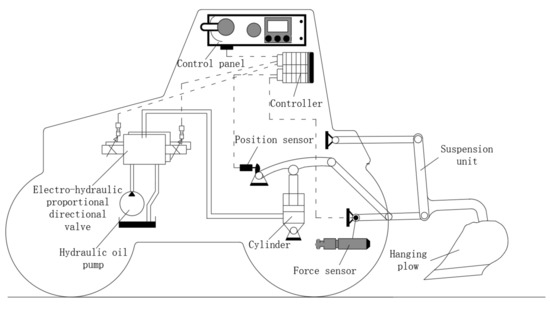
Figure 1.
Main module structure diagram of the operating system inside.
Before the tractor starts its operation, the driver can set the corresponding parameters through the control panel according to the operation requirements. During the operation, the sensor elements such as force and position monitor the operating status of the system in real-time, and the detected operating data are processed and fed back to the controller and then compared with the target signal, and the corresponding output signal is obtained through the pre-stored control algorithm. After this signal is amplified, the opening and direction of the proportional reversing valve are adjusted to realize the automatic control of the lifting and movement speed of the suspended plow.
2.1.2. Operating System Regulation Mechanism
When the operating system is farming, it is simultaneously affected by the depth of the plow and the resistance of the soil. Therefore, in this paper, sensors are used to measure farming data in real-time and introduce the idea of weight distribution to organically couple the plow depth and the force of the plow to form a comprehensive control of the force–position, as shown in Figure 2.

Figure 2.
Block diagram of the force–position comprehensive adjustment control principle.
Before tractor plowing, the driver sets the target values of plowing depth and traction through the control panel and selects a weighting coefficient in advance according to experience. In the tillage process, the actual tillage depth signal is calculated according to the weight from the feedback signal provided by the position sensor and the feedback signal converted by the traction sensor and compared with the set target to generate the corresponding deviation signal. Then, according to the control algorithm developed in advance, the corresponding command signal is sent to drive the action of the electro-hydraulic proportional valve, regulate and control the suspension unit, and then change the soil depth of agricultural machines and tools.
The force–position comprehensive adjustment control depends on the proportion of force control and position control of the weight coefficient a. The relationship is:
where H represents the real-time depth of the plow (cm); Hy represents the plow depth feedback value (cm); HF represents the plow depth conversion value.
Therefore, when a = 0—that is, Hy = 0, H = HF—the system only performs force-adjustment control; when a = 1—that is, HF = 0, H = Hy—the system only carries out position adjustment control; when 0 < a < 1, the system assigns the adjustment control weight according to the value of a, and obtains the comprehensive value of tillage depth after superposition and transformation.
2.2. Design of the Fuzzy Controller with a Variable Universe
Tractor field farming results from the coupling of many types of factors that have strong nonlinearity, so it is difficult for the classic PID algorithm to exert its advantages. The traditional fuzzy controller has a simple structure, but it has obvious defects. That is, when the input variable of the fuzzy controller is too large and the domain of the input variable is too small, the output value of the controller cannot meet the system requirements. When the input variable of the fuzzy controller is too small and the domain of the input variable is too large, most fuzzy rules are idle. In recent years, people have begun to introduce ideas such as fuzzy algorithms with intelligent attributes and variable-universe theory into the adjustment control of cultivation depth [11]. Therefore, this article demonstrates the design of a coupling controller based on the existing fuzzy algorithm and introduces the theory of a fuzzy-inference-type variable universe.
2.2.1. Control Algorithm and Structure
The core of the variable-universe theory [19] introduces the expansion factor controller based on unchanged original control rules and precisely scales the basic universe in real-time, which can greatly improve the operation quality and accuracy of the farming unit [20,21]. The principle block diagram is shown in Figure 3.
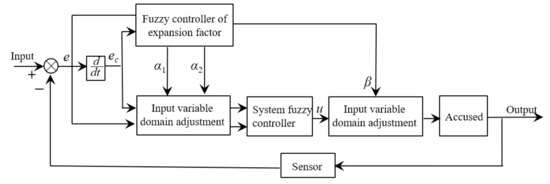
Figure 3.
Block diagram of control algorithm structure principle.
Parameter e represents the input deviation of the control system, represents the change rate of the input deviation of the control system, and represent the input scaling factors, β represents the output-scaling factor.
When the operating system is running, the farming depth difference e and its change rate are transmitted to the controller in real-time, and then the expansion factor controller obtains the corresponding change according to its own logic and participates in the universe transformation of the fuzzy controller of the system, making it closer to the ideal interval, realizing the real-time dynamic adjustment of the basic universe.
2.2.2. Design of the Fuzzy Controller System
Based on the traditional fuzzy control, combined with expert experience and a large amount of historical test data, according to the basic structure of the control algorithm, the fuzzy controller [22] of the system uses the form of two inputs and one output, in which the tillage depth difference and its change rate are input parameters, and the tillage depth adjustment u is the output parameter.
To satisfy the tractor’s intricately changing farming environment, the basic universes of the tillage depth difference and its change rate are, respectively, taken as [−12,12] and [−50,50], and the universe of adjustment u is taken as [−3.6,3.6]; and the three variables are all with [−6,6] as their fuzzy universe. At the same time, to cover each variable more comprehensively, 7 subsets {NB, NM, NS, Z, PS, PM, PB} are selected to show the dynamics of each parameter. The subsets of respectively indicate that the current tillage depth is compared with the set tillage depth as: “extremely large depth”, “great depth”, “general depth”, “same depth”, “shallow depth”, “very shallow depth”, “extremely shallow depth”; the subset of means “very fast deepening speed”, “higher deepening speed”, “slower deepening speed”, “changing speed unchanged”, “slower shallowing speed”, “faster shallowing”, “extremely fast shallowing”, and the membership relationship between each variable is described with a triangle, as shown in Figure 4.
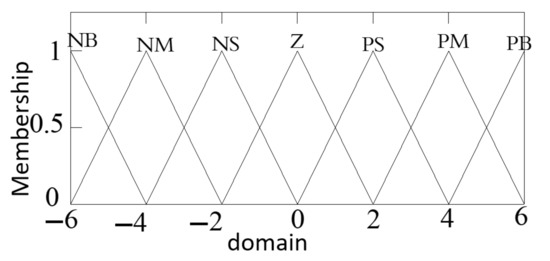
Figure 4.
Schematic diagram of the membership of each variable.
- (1)
- When the tillage depth error is positive or negative, a reverse tillage depth adjustment amount should be applied to speed up the system response speed and ensure the accuracy of the tillage depth.
- (2)
- When the tillage depth is positive or negative and is negative or positive, the tillage depth adjustment amount should not be applied to ensure the stability of the system.
- (3)
- When the tillage depth is positive or negative, as changes from negative to positive, an adjustment amount of tillage depth opposite to should be applied to offset the change in tillage depth caused by changes in .
- (4)
- When the tillage depth is positive or negative, or basically remains unchanged, as changes from negative to positive, a tillage depth adjustment amount opposite to and a smaller value should be applied to ensure that the tillage depth will not change to the opposite direction.
The control rule is the key of the fuzzy controller. Based on the comprehensive analysis of the tractor field farming data, the relationship between the characteristics of the operating system and the internal variables is studied, and the system’s fuzzy control rules as shown in Table 1 are obtained.

Table 1.
Basic control rules of the operating system.
Combining the characteristics of the operating system, the more advantageous center-of-gravity method is selected to obtain accurate values in the clarification process. The expression is:
represents the adjusted tillage depth value, represents the value of tillage depth at point n, and represents the adjustment amount at .
2.2.3. Design of the Fuzzy Controller with an Expansion Factor
The expansion factor controller uses the form of two inputs and three outputs, and its parameter input values have not changed, while the output parameters become expansion factors α1, α2, and β. Combining the basic principles of the control algorithm, the expansion factor α1 and α2 act on the input of the fuzzy controller of the system to fine-tune its input parameters; the expansion factor β acts on the output of the fuzzy controller of the system to complete the “fine adjustment” of the output parameters.
Real-time scaling of the basic universe by the expansion factor is the key to the variable-universe theory, so to improve the work’s effectiveness, in this paper, the fuzzy-reasoning expansion factor is selected, and the controller design idea is consistent with the fuzzy controller system, so there is no need to repeat its design process. However, its control rules are obtained based on deviation approximation theory and operating experience, as shown in Table 2.

Table 2.
The universe adjustment rules of α1, α2, and β.
2.3. Software and Hardware Design of the Control Module
The control module is the key to realizing the precise control of tillage depth by the electronically controlled hydraulic suspension system. The software and hardware design of this system are based on Freescale MC9S12XS128.
2.3.1. Hardware Design of the Control Module
According to the requirements of system operation, the control module hardware should have a virtual terminal, signal acquisition and processing, serial communication, and signal output and drive units in addition to the basic circuit [23,24]. Its structure principle is shown in Figure 5.
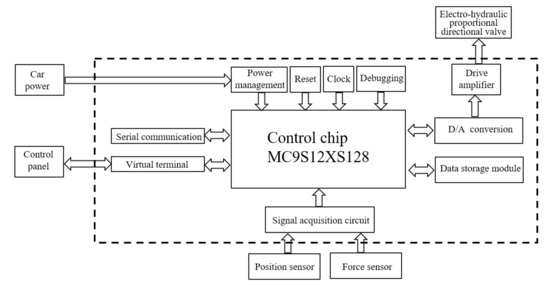
Figure 5.
Block diagram of the hardware structure of each unit of the control module.
When the tractor works in tillage depth, the control chip MCU compares the target parameter of the control panel and the feedback signal of the sensor element and then calculates and processes it according to the set control algorithm, outputs the corresponding PWM value after D/A conversion, and amplification processing for the adjustment of the opening degree and direction of the reversing valve, then adjusts the posture of the plow and the height into the soil in real-time.
To avoid electromagnetic interference and ensure efficient and accurate signal transmission, a 0.1 μF capacitor C17 is connected in series at the output terminal of the hardware circuit, and other different units are packaged or soldered on the PCB board to obtain the control module development board shown in Figure 6.
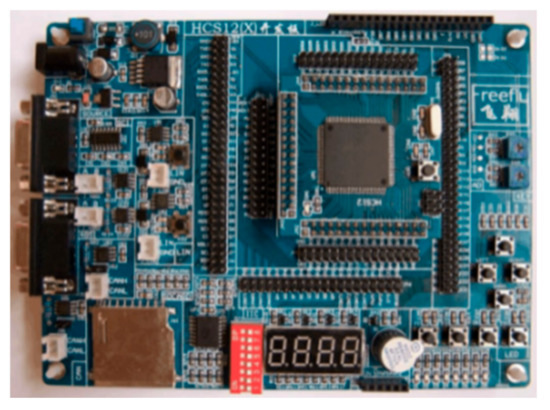
Figure 6.
Control module of operation system.
2.3.2. Software Design of the Control Module
As each unit of the control module has different functions, does not interfere with each other, and has strong sharing characteristics, this paper introduces a modular theoretical design system software program in the software design of the control module, and its depth adjustment and algorithm analysis is shown in Figure 7.
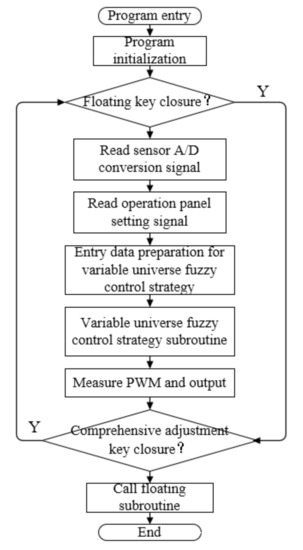
Figure 7.
Design process of tillage depth adjustment.
When the joint automatic adjustment pin is at a low level, the system executes the joint adjustment subroutine after initialization and judges whether the floating key is closed. If it is closed, the system directly calls the floating adjustment subroutine and does not execute the plow depth adjustment instruction. If the floating key is turned on, the system transmits the information to the main control unit after completing the A/D conversion, judging the adjustment mode required by the current state, calculating the PWM output signal according to the corresponding algorithm, and then sending the lifting command to the suspension unit. During the tractor farming process, the joint adjustment key is always closed, and the system continues to execute the joint automatic adjustment subroutine until the farming is completed, the joint adjustment key is opened, and the system returns to the floating state, as shown in Figure 8.
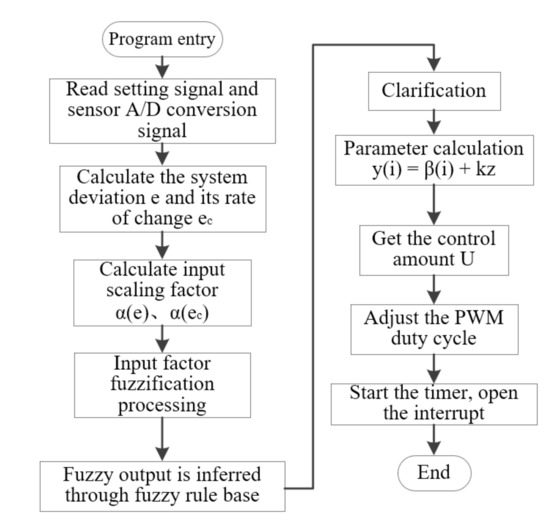
Figure 8.
Design process of control algorithm.
3. Results
Whether the tractor farming system can play its control advantages in the intricately changing soil environment requires experiments to compare its performance differences.
To enhance the target of tractor field trials and save research and development time and costs, in this paper, the basic theoretical model of the plowing operation system shown in Figure 9 is established based on Matlab/Simulink and compares and analyzes the response of different control algorithms.
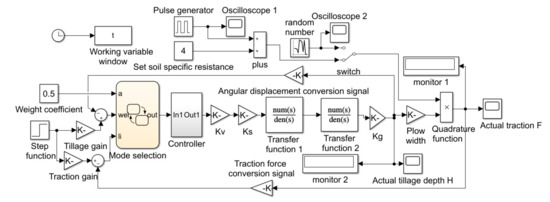
Figure 9.
Basic theoretical model of plowing operation system.
Before the simulation starts, the simulation duration is set to 50 s and the weight coefficient is set to 0.5. At the same time, to simulate the soil-mutation signal, a step signal with a vibration amplitude of 0.4 and an action time of 2 s is added at 2 s. After the simulation is turned on, the response of the three control algorithms of PID, fuzzy, and the variable-universe fuzzy is shown in Figure 10 [25].
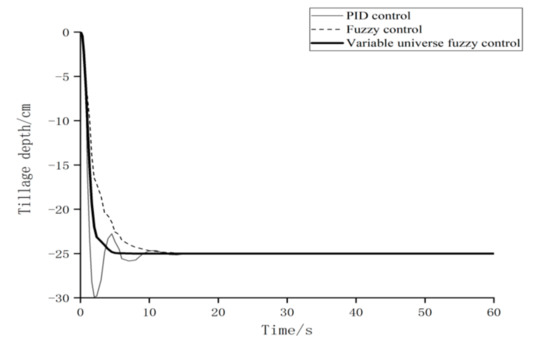
Figure 10.
Response curves of different control algorithms.
Comparing the simulation curves, it can be seen that the PID control response is the fastest, but it has an overshoot of 19.2%, which takes 1 s to stabilize; although the fuzzy control has no overshoot, its response is the slowest and takes 0.9 s to stabilize; the variable-universe fuzzy control has no overshoot, and the response takes only 0.56 s to stabilize. Comprehensive analysis, the variable-universe fuzzy control has superior response characteristics.
4. Discussion
4.1. Test Conditions and Scheme
To explore whether the variable-universe fuzzy control algorithm can maintain its superior performance in actual tillage operations, the PH1404 tractor is used as the carrier, and the 1LF-435 four-shaft flip plow is attached. A comparative test of three control algorithms is performed on the same relatively flat test plot, and the test scene is shown in Figure 11.
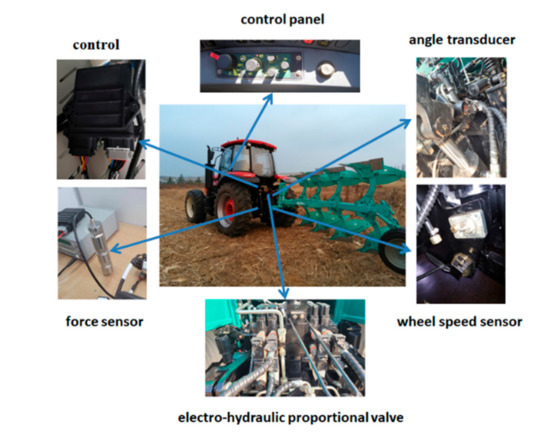
Figure 11.
Field test scene of tractor.
After completing the preliminary preparations such as plow leveling and sensor element calibration on the test plot, the tractor’s tillage depth is set to 25 cm, the traction force is set to 7000 N, the weight coefficient is set to 0.5, and the operation speed is about 7.5 km/h with B2 gear in field trials.
4.2. Test Data Collection and Result Analysis
After the experiment, the tillage data of the three control algorithms were sorted and analyzed, and the comparison curves of tillage depth and traction force of the operating system under different control algorithms were drawn with the help of Matlab analysis software, as shown in Figure 12.
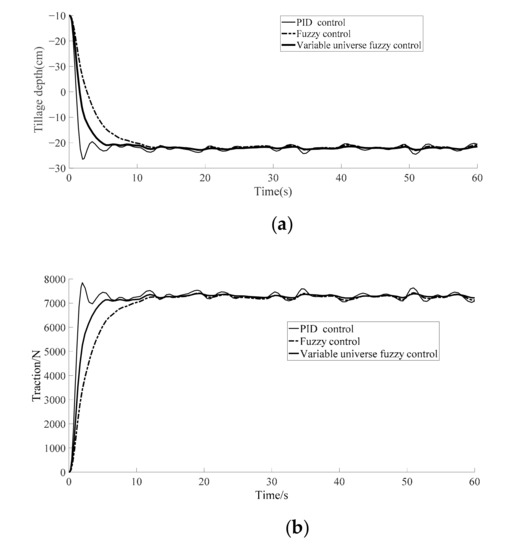
Figure 12.
Comparison curves of tractor tillage depth and traction force test under different control algorithms. (a) Variation curve of tillage depth. (b) Variation curve of traction.
According to Figure 12, in the early response stage (0–10 s) of the test, the PID control has the fastest response speed, but the maximum tillage depth is 28.26 cm, the overshoot is 13.04%, and the maximum traction is 7848 N, which exceeds the set value of 12.11%, and it takes 10.56 s to stabilize; the fuzzy control solves the problem of system overshoot, but its response speed is slow, and the adjustment time is also increased to 13.43 s to reach the target value; compared with the former two, the variable-universe fuzzy control not only avoids the overshoot phenomenon but also improves the response speed and only takes 5.85 s to reach the steady state.
During the steady-state fluctuation phase of the experiment (20–60 s), the maximum tillage depth of the PID control is 27.26 cm, the minimum is 24.12 cm, and the deviation interval is 3.14 cm; the maximum traction force controlled by PID is 7625 N, the minimum is 6783 N, and the deviation interval is 842 N. PID control farming uniformity is poor and load fluctuation is obvious. The extreme value of the fuzzy control tillage depth is 26.53 cm and 24.43 cm, respectively, and the extreme value of the traction force is 7425 N and 6871 N, respectively, and the tillage quality has been improved. The extreme values of tillage depth of the variable-universe fuzzy control are 26.35 cm and 24.75 cm, respectively, and the deviation range is reduced to 1.6 cm; the extreme values of traction force are 7388 N and 6960 N, respectively, and the deviation range is improved to 428 N, so its work quality and load stability have been significantly improved.
Therefore, by comparing the test results of the three control algorithms, it can be seen that the variable-universe fuzzy control responds quickly and has no overshoot; after the steady state, its tillage depth and traction force fluctuation range are smaller, the engine power output is more stable, its value is closer to the set target value, and it can provide better soil preparation for crop growth.
5. Conclusions
To improve tractor field-farming quality and control accuracy, firstly, based on the existing operating system structure, the operation mechanism of comprehensive force–position regulation is discussed, and at the same time, the variable-universe fuzzy algorithm with intelligent attributes is introduced into the lifting and posture control of the electronically controlled hydraulic suspension operating system. The software and hardware of the control module were designed based on the MC9S12XS128 chip, and then the experimental research was carried out. The test results show that the tillage-depth adjustment system using variable-universe fuzzy control responds quickly and does not have overshoot problems; under normal tillage conditions, its tillage depth and traction forces are closer to the expected value, which further improves the quality and efficiency of the system’s operation. The variable-universe fuzzy control provides technical support for future field management of intelligent agricultural machinery and intensive farming.
When variable domain fuzzy technology is applied to deep-tillage field operation, the control system has high response speed without overshoot, which improves the reliability of tillage; the traction fluctuation of this operation is small, which can better track the set target value, improve the stability of farming, and further improve the quality of farming. Variable-domain fuzzy control provides technical support for the future field management of intelligent agricultural machinery and intensive agriculture.
6. Patents
- Ruichuan Li, Jikang Xu, Chengliang Liu et al. AMT hydraulic shift executive system with pressure limiting and positioning function: China, CN201710045884.6. 28 August 2018.
- Ruichuan Li, Jikang Xu, Chengliang Liu et al. An AMT gear selection and shifting hydraulic executive system with pressure limiting and positioning function: China, CN201710045916.2. 21 August 2018.
- Chengliang Liu, Ruichuan Li, Jikang Xu et al. Silicon steel sheet superimposed force sensor: China, CN201811417081.X. 25 January 2019.
- Ruichuan Li, Chengliang Liu, Jikang Xu et al. Dual accumulator braking energy recovery system based on hydro mechanical continuously variable transmission: China, CN201811359976.2. 29 January 2019.
- Chengliang Liu, Ruichuan Li, Jikang Xu et al. Double planet five section hydro mechanical continuously variable transmission: China, CN201811359946.1. 1 February 2019.
- Chengliang Liu, Ruichuan Li, Jikang Xu et al. New traction sensor: China, CN201811417105.1. 25 February 2019.
- Ruichuan Li, Hongmei Han, Jikang Xu et al. A multi parameter United automatic regulation system for tractor plowing depth: China, CN202020106874.6. 10 November 2020.
Author Contributions
Conceptualization, J.X. and Y.L.; methodology, R.L. and J.X.; software, Y.L. and Y.M.; validation, J.X., R.L., Y.L. and Y.Z.; formal analysis, J.X. and X.D.; investigation, Y.L.; data curation, Y.L.; writing—original draft preparation, J.X. and H.S.; writing—review and editing, J.X., R.L., Y.L. and Y.Z.; visualization, Y.L.; project administration, J.X.; funding acquisition, R.L. All authors have read and agreed to the published version of the manuscript.
Funding
This research was funded by 2020 Shandong Province Key Research and Development Program (Major Technological Innovation Project), Large Tractor Hydraulic CVT Intelligent Continuously Variable Transmission Integration Research and Application (2020CXGC010806), and 2020 Shandong Province Key Research and Development Program (Major Technological Innova-tion Project), Con-struction Machinery Integration Research and Application of Key Technologies for Intelligent Integration and Matching of Vehicle Assembly (2020CXGC011005), and 2020 Jinan City Science and Technology Bureau University Institute Innovation Team Project, Research on Key Technologies of Intelligent Electro-hydraulic Control System for Large Power Platform (2020GXRC042).
Institutional Review Board Statement
Not applicable.
Informed Consent Statement
Not applicable.
Data Availability Statement
The data presented in this study are available on request from the corresponding author.
Acknowledgments
I would like to thank my tutor, R.L. for all his support and guidance. I would also like to express my gratitude to my coworkers for their support and understanding, without whom I would never have completed the research. I would also especially like to thank my family and friends, who listened to my frustrations and believed in me, sometimes more than I believed in myself.
Conflicts of Interest
The authors declare no conflict of interest.
References
- Li, M.S.; Zhao, J.J.; Zhu, Z.X.; Xie, B.; Chi, R.; Mao, E.R. Fuzzy-PID Self-adaptive control method in electro-hydraulic hitch system. J. Agric. Mach. 2013, 44, 295–300. [Google Scholar]
- Yang, J.R.; Mu, C.P.; Li, R.C.; Ma, R.; Gao, Y.; Liu, C.Y. Analysis and experimental research on the control method of tractor tillage depth. Agric. Mech. Res. 2020, 42, 235–239. [Google Scholar]
- Ma, Y.; Li, R.C.; Xu, J.K.; Liu, Z.; Zhao, P.; Liu, Y.J. Study on the Fuzzy PID auto-control strategy for tractor tillage depth. Agric. Mech. Res. 2019, 41, 241–247. [Google Scholar]
- Wang, S.Y.; Liu, Z.; Li, R.C.; Xu, J.K.; Liu, Y.J. Variable weight force-position mixed control of high-power tractor based on soil specific resistance. J. Agric. Mach. 2018, 49, 351–357. [Google Scholar]
- Shen, Z.F. Modeling and Simulation Analysis of Tractor Electric Control Hydraulic Suspension System; Jiangsu University: Zhenjiang, China, 2010. [Google Scholar]
- Hong, W.; Ming, Y.; Yu-xian, Z.; Qing-xia, L.; Miao, L.; Bong-bing, Y.; Li-fu, W.; Fang, Y. Design on dynamic measuring and controlling system of driver. In Proceedings of the 2010 International Conference on Computer Mechatronics, Control and Electronic Engineering, Changchun, China, 24–26 August 2010; IEEE: Guilin, China, 2010; pp. 442–444. [Google Scholar]
- Imran, S.M.; Raheman, H.; Rajeev, S.; Abhisek, K. An electromechanical implement lift system with position control for low horse power tractor. Agric. Eng. Int. CIGR J. 2014, 16, 112–121. [Google Scholar]
- Zhang, S.; Du, Y.; Zhu, Z.; Mao, E.; Liu, J.; Shi, J. Integrated control method of traction & slip ratio for rear-driving high-power tractors. Trans. Chin. Soc. Agric. Eng. 2016, 32, 47–53. [Google Scholar]
- Ma, Y.; Li, R.C.; Li, Y.S.; Xu, J.K.; Zhao, P.; Liu, Y.J. Study on uniformity of tractor tillage depth in different soil specific resistance. Agric. Mech. Res. 2019, 41, 156–160. [Google Scholar]
- Liu, Z. Design and Analysis of a High-Power Tractor Electro-Hydraulic Suspension Control System based on Soil Specific Resistance; Shandong University of Science and Technology: Qingdao, China, 2018. [Google Scholar]
- Ma, Y.; Li, R.C.; Liu, Y.J. Study on control method of agricultural tractor plowing based on slip rate. Agric. Mech. Res. 2020, 42, 259–263. [Google Scholar]
- Opdenbosch, P.; Sadegh, N.; Book, W. Intelligent controls for electro-hydraulic poppet valves. Control Eng. Pract. 2013, 21, 789–796. [Google Scholar] [CrossRef]
- Mohammadikia, R.; Aliasghary, M. Design of an interval type-2 fractional order fuzzy controller for a tractor active suspension system. Comput. Electron. Agric. 2019, 167, 105049. [Google Scholar] [CrossRef]
- Wang, S.; Liu, Y.; Wang, Z.; Dong, P.; Cheng, Y.; Xu, X.; Tenberge, P. Adaptive fuzzy iterative control strategy for the wet-clutch filling of automatic transmission. Mech. Syst. Signal Process. 2019, 130, 164–182. [Google Scholar] [CrossRef]
- Sabouri, Y.; Abbaspour-Gilandeh, Y.; Solhjou, A.; Shaker, M.; Szymanek, M.; Sprawka, M. Development and laboratory evaluation of an online controlling algorithm for precision tillage. Sensors 2021, 21, 5603. [Google Scholar] [CrossRef] [PubMed]
- Ding, R.; Cheng, M.; Jiang, L.; Hu, G. Active fault-tolerant control for electro-hydraulic systems with an independent metering valve against valve faults. IEEE Trans. Ind. Electron. 2020, 68, 7221–7232. [Google Scholar] [CrossRef]
- Zhao, J.; Lu, Y.; Guo, M.; Fu, J.; Wang, Y. Design and experiment of bionic stubble breaking-deep loosening combined tillage machine. Int. J. Agric. Biol. Eng. 2021, 14, 123–134. [Google Scholar]
- Soylu, S.; Carman, K. Fuzzy logic based automatic slip control system for agricultural tractors. J. Terramechanics 2021, 95, 25–32. [Google Scholar] [CrossRef]
- Li, H.; Li, S.; Sun, W.; Wang, L.; Lv, D. The optimum matching control and dynamic analysis for air suspension of multi-axle vehicles with anti-roll hydraulically interconnected system. Mech. Syst. Signal Process. 2020, 139, 106605. [Google Scholar] [CrossRef]
- LI, L.F. Research on Variable Universe Fuzzy Control Algorithm; University of Electronic Science and Technology of China: Chengdu, China, 2008. [Google Scholar]
- Zhang, X. Research on Three-Stage Inverted Pendulum Controller Based on Variable Universe Adaptive Fuzzy Control Theory; Dalian University of Technology: Dalian, China, 2010. [Google Scholar]
- Yuan, X.; Chen, Z.; Yuan, Y.; Huang, Y. Design of fuzzy sliding mode controller for hydraulic turbine regulating system via input state feedback linearization method. Energy 2015, 93, 173–187. [Google Scholar] [CrossRef]
- Zhao, J.; Zhu, Z.; Song, Z.; Zhou, R.; Wang, R.; Mao, E. Proportional controller for electro-hydraulic hitch system in heavy tractor. J. Agric. Mach. 2014, 45, 10–16. [Google Scholar]
- Yin, Y.; Wang, C.; Meng, Z.; Chen, J.; Guo, S.; Qin, W. Operation quality measurement method for tilling depth of suspended subsoiler. Trans. Chin. Soc. Agric. Mach. 2018, 49, 68–74. [Google Scholar]
- Ma, Y. Research on Heavy Tractor Tillage Control Technology Based on Variable Universe Fuzzy PID; Shandong University of Science and Technology: Qingdao, China, 2019. [Google Scholar]
Publisher’s Note: MDPI stays neutral with regard to jurisdictional claims in published maps and institutional affiliations. |
© 2021 by the authors. Licensee MDPI, Basel, Switzerland. This article is an open access article distributed under the terms and conditions of the Creative Commons Attribution (CC BY) license (https://creativecommons.org/licenses/by/4.0/).